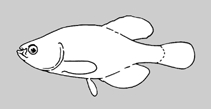Argolebias guarani AlonsoCalviñoTeránSerraMontesGarcíaBarnecheAlmirónCioteket al., 2023
Envoyez vos Photos et vidéos
Images GoogleNo image available for this species;
drawing shows typical species in Rivulidae.
Images GoogleNo image available for this species;
drawing shows typical species in Rivulidae.
Classification / Names Noms communs | Synonymes | Catalog of Fishes(Genre, Espèce) | ITIS | CoL | WoRMS | Cloffa
> Cyprinodontiformes (Rivulines, killifishes and live bearers) > Rivulidae (Rivulines) > Cynolebiinae
Etymology: guarani: Named for the Guaraní indigenous people, who live in several settlements very close to the type locality of this species, as a vindication of their culture and history.
Etymology: guarani: Named for the Guaraní indigenous people, who live in several settlements very close to the type locality of this species, as a vindication of their culture and history.
Environment: milieu / climate zone / depth range / distribution range Écologie
; eau douce pélagique; profondeur 0 - 1 m (Ref. 129129). Tropical
Distribution Pays | Zones FAO | Écosystèmes | Occurrences | Point map | Introductions | Faunafri
South America: Argentina.
Taille / Poids / Âge
Maturity: Lm ? range ? - ? cm
Max length : 5.5 cm SL mâle / non sexé; (Ref. 129129); 3.8 cm SL (female)
Max length : 5.5 cm SL mâle / non sexé; (Ref. 129129); 3.8 cm SL (female)
Description synthétique Clés d'identification | Morphologie | Morphométrie
This species is distinguished from its congeners by having a unique colour pattern consisting of the following: mature males when alive with scattered small dark brown to grey irregular blotches on the laterodorsal surface of head and anterior portion of trunk, with many and relatively big sub-square irregular iridescent turquoise to light blue blotches on unpaired fins, evenly distributed, and those in the distal portion are elongated and merging, the trunk and tail with anterocentral part of scales iridescent turquoise with grey borders generating a reticulated pattern, the thin external border of the scales in the dorsal part of trunk, below the dorsal fin, are iridescent turquoise, and orange-yellowish background coloration on the base of unpaired fins and yellowish belly; in juveniles and young adults, anterior nostrils are ventrolaterally directed (Ref. 129129).
Found only in its type locality which is a seasonal pond, mainly covered with grass, in the Paraná Forest at ca.185 m a.s.l.. It is in an open space, in the surrounding jungle, with abundant palm trees. Maximum depth measured was ca. 80 cm, and the water was clear and no submerged aquatic vegetation was observed. The bottom is of soft sediment, with abundant organic
matter (Ref. 129129).
Life cycle and mating behavior Maturité | Reproduction | Frai | Œufs | Fécondité | Larves
Référence principale
Upload your references | Références | Coordinateur : Costa, Wilson J.E.M. | Collaborateurs
Alonso, F., G. E. Terán, W.S. Serra Alanís, P. Calviño, M.M. Montes, I.D. García, J.A. Barneche, A. Almirón, L. Ciotek, P. Giorgis and J. Casciotta, 2023. From the mud to the tree: phylogeny of Austrolebias killifishes, new generic structure and description of a new species (Cyprinodontiformes: Rivulidae). Zool. J. Linn. Soc. 199:280-309. (Ref. 129129)
CITES
Not Evaluated
Menace pour l'homme
Harmless
Utilisations par l'homme
Pêcheries: sans intérêt
FAO - Publication: search | FishSource |
Plus d'informations
Trophic ecology
Éléments du régime alimentaire
Composition du régime alimentaire
Consommation alimentaire
Food rations
Prédateurs
Éléments du régime alimentaire
Composition du régime alimentaire
Consommation alimentaire
Food rations
Prédateurs
Ecology
Écologie
Écologie
Population dynamics
Paramètres de croissance
Max. ages / sizes
Length-weight rel.
Length-length rel.
Fréquences de longueurs
Mass conversion
Recrutement
Abondance
Paramètres de croissance
Max. ages / sizes
Length-weight rel.
Length-length rel.
Fréquences de longueurs
Mass conversion
Recrutement
Abondance
Life cycle
Reproduction
Maturité
Maturity/Gills rel.
Fécondité
Frai
Spawning aggregations
Œufs
Développement de l'œuf
Larves
Dynamique des populations larvaires
Reproduction
Maturité
Maturity/Gills rel.
Fécondité
Frai
Spawning aggregations
Œufs
Développement de l'œuf
Larves
Dynamique des populations larvaires
Anatomy
Surface branchiale
Brain
Otolith
Surface branchiale
Brain
Otolith
Physiology
Body composition
Nutrients
Consommation d'oxygène
Type de nage
Vitesse de nage
Visual pigments
Fish sound
Diseases & Parasites
Toxicity (LC50s)
Body composition
Nutrients
Consommation d'oxygène
Type de nage
Vitesse de nage
Visual pigments
Fish sound
Diseases & Parasites
Toxicity (LC50s)
Genetics
Génétique
Heterozygosity
Héritabilité
Génétique
Heterozygosity
Héritabilité
Human related
Aquaculture systems
Profils d'aquaculture
Souches
Ciguatera cases
Stamps, coins, misc.
Aquaculture systems
Profils d'aquaculture
Souches
Ciguatera cases
Stamps, coins, misc.
Outils
E-book | Guide de terrain | Générateur de fréquences de longueur | Outil de dynamique de population | Carte par point | Classification Tree
| Catch-MSY |
Articles particuliers
Télécharger en XML
Sources Internet
AFORO (otoliths) | Aquatic Commons | BHL | Cloffa | BOLDSystems | Websites from users | FishWatcher | CISTI | Catalog of Fishes: Genre, Espèce | DiscoverLife | ECOTOX | FAO - Publication: search | Faunafri | Fishipedia | Fishtrace | GenBank: génôme, nucléotide | GloBI | Google Books | Google Scholar | Google | IGFA World Record | MitoFish | Otolith Atlas of Taiwan Fishes | PubMed | Reef Life Survey | Socotra Atlas | Arbre de Vie | Wikipedia: aller à, chercher | World Records Freshwater Fishing | Zoobank | Zoological Record
Estimates based on models
Phylogenetic diversity index (Ref. 82804): PD50 = No PD50 data [Uniqueness, from 0.5 = low to 2.0 = high].
Bayesian length-weight: a=0.00891 (0.00396 - 0.02008), b=3.14 (2.94 - 3.34), in cm total length, based on LWR estimates for this (Sub)family-body shape (Ref. 93245).
Niveau trophique (Ref. 69278): 3.2 ±0.4 se; based on size and trophs of closest relatives
Résilience (Ref. 120179): Haut, temps minimum de doublement de population inférieur à 15 mois (Preliminary K or Fecundity.).
Fishing Vulnerability (Ref. 59153): Low vulnerability (10 of 100).




